Switzerland / Austria – 23/27-08-15
Around three o'clock in the afternoon I leave for Switzerland with Jordi and my father-in-law. Somewhere around midnight we arrive at the Albula Pass and while enjoying a beer we enjoy the Perseids (shooting stars). After an hour we prepare for a few hours of sleep in the car.After lying down for about five hours, we go out around six o'clock to look for butterflies. As is often the case this year, the numbers of butterflies are very disappointing, we find some Agrodiaetus damon - Damon Blue, but there are not many. With a lot of effort I manage to take a reasonable photo of the Agrodiaetus damon - Damon Blue.
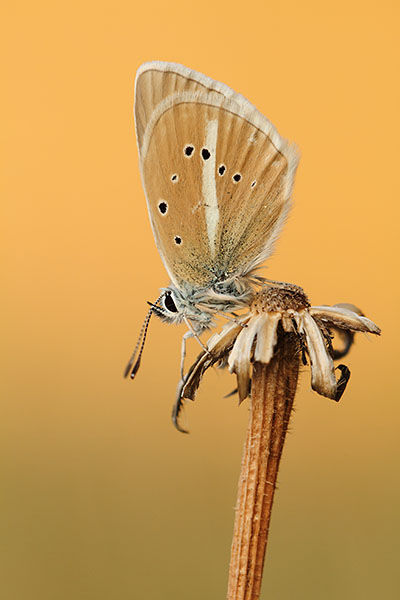
In the afternoon we walk through some fields, but everywhere the butterflies seem to have already flown out.
After another short night we now decide to drive towards Austria in an attempt to find the Azure hawker - Aeshna caerulea. It is a place we have never been before, and once we arrive there appears to be a chair lift and a small paved path leading up. Since a barrier is up, we decide to go up by car. The path soon turns out to be narrower than expected and the loose gravel also makes it a dramatic ride. After ten minutes I'm done with it, but turning is not an option so we drive on quietly. We finally arrive at the top of the mountain an hour later and find ourselves in the middle of a ski slope. A beautiful view, but I'm already dreading the return journey.
Fortunately, the first Azure glaziers soon find themselves, which brightens the mood. But if we haven't been able to take a photo after a few hours, the mood quickly deteriorates. Eventually one settles, but then right on Jori's shirt. After this we are fed up and start the dead ride down again. Once we reach the bottom, someone is repairing the barrier and starts shouting at us in the most obnoxious way possible in Austrian. It was probably not the intention to go up by car.
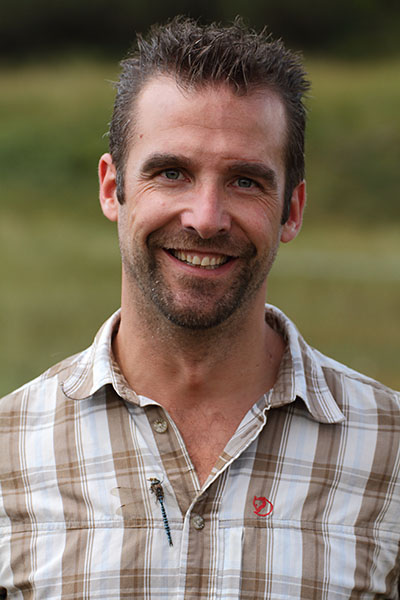
Once back at our hotel in Switzerland, the weather turns out to be a bit less the next day, so there is no reason to get up early. After a good night's sleep, we will try to find Azure glass makers in Switzerland. I had a nice mountain lake in mind, which seemed easy to walk on Google maps. Once I started the walk, my father-in-law gave up after fifteen minutes. At first we continue walking happily, but after an hour we are completely exhausted and there is not a lake to be seen. I don't know how long it will take to travel, but we think the lake is beautiful. There are several Somatochlora alpestris - Alpine Emerald flying around that don't want to sit down, and the Azure hawker - Aeshna caerulea seems to be untraceable here too. When it starts to rain after about an hour, the fun is over here too and we decide to start the long journey down again. We get back to the hotel on time, and because the weather will be bad the next day, we don't have to leave early.
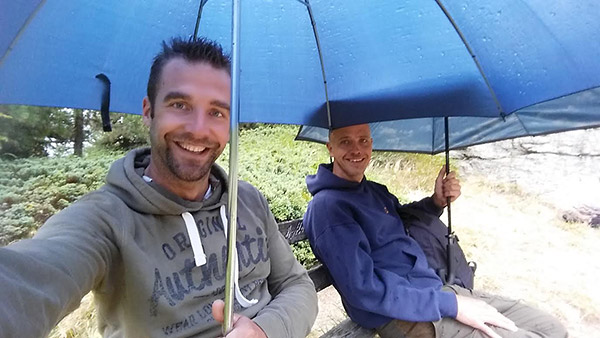
To do something today we decide to look for Salamandra atra - Alpine Salamander. I found a good place in Austria, so we're going there today. Once we arrive at our destination, it turns out that we cannot park as close as we hoped and again a long and difficult walk awaits us. After walking for about two hours we find the first two salamanders and immediately start photographing them. Just as soon it starts to rain, and not just a little bit either. It's coming down in buckets. With the camera under the umbrella we can continue taking photos for a few hours despite the rain. A few hours later we are completely soaked and cold to the bone. Since the weather doesn't seem to be getting any better, we head back to the car. Salamanders have now emerged along the entire path back, so the long walk appears to have been unnecessary. But once in the car, all the rain is quickly forgotten and we think about what we will do on the last day.
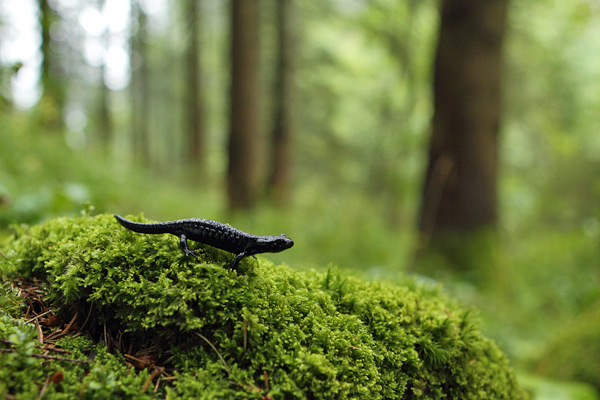
We check the weather forecast for the rest of Europe but it seems to be raining everywhere. Because it is still early in the afternoon, we decide to drive to the Eiffel to spend the night there and see if there are any late Pale Blues to be found here. We arrive in the dark and quickly go to sleep in the car somewhere along the side of the road. The next morning we take a short walk to see if it is worth photographing, but most of the butterflies already look old, and the weather is not good either. We don't bother to take a picture and head home.
Summer holiday Italy (2015)
As is often the case, I am very behind in putting my photos online. The new season has almost started and I still have a few minor updates to go. The biggest update is probably from the summer holiday to Elba, Italy, where I spent three weeks with the whole family. For me, there should be four new species of butterflies on this island. Since it involved two butterflies, a blue butterfly and a haybird, I somewhat expected to find one or more of these species around our house. After a week I had unfortunately only seen a handful of butterflies in the area and nothing that was really worth spending too much time on. When I was finally studying a map of the island I came across a “butterfly path”, which was supposedly specially constructed for watching butterflies. Of course we left early the next day to go here. Before the sun was up (about 20 degrees) I was at the beginning of the path that seemed to go up a mountain. During the first ten minutes I saw a lot of sand-eyes flying everywhere, but nothing of the species I was looking for. Once I leave the forest and follow the path between the bare rocks, I suddenly see several butterflies flying. Without picking up the book, it is clear that this is a type of moth that I have never seen before, it is the Hipparchia neomiris - Corsican Grayling that has a very striking top in flight.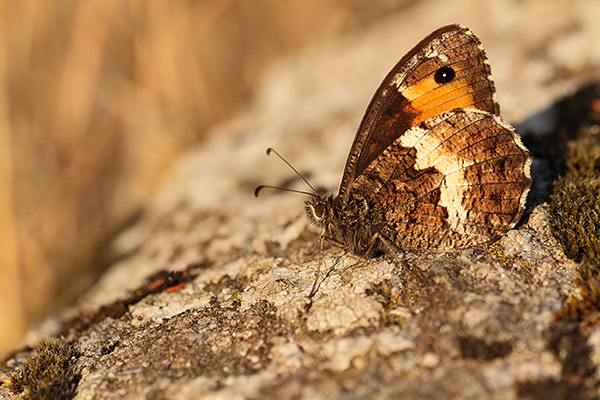
A little later I also come across a duller colored moth among the Corsican moths, which ultimately turns out to be a Hipparchia aristaeus - Southern Grayling. That was the other butterfly I was hoping to find. This one generally seems a bit more shy and is not easy to photograph, but in the end I take a (somewhat boring) picture of it anyway.
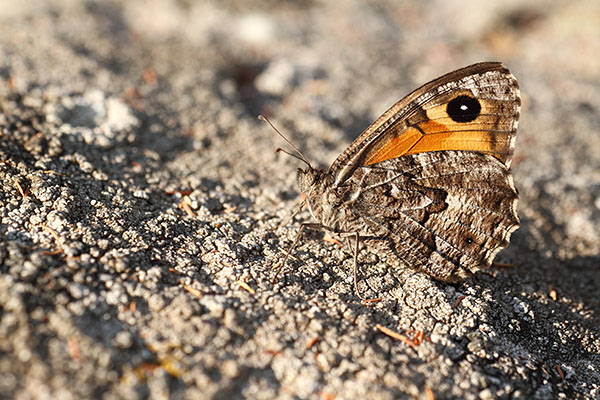
Because of all the flying behind these butterflies, I didn't pay attention at all, but the Plebejus villai - Elban Blue is also flying everywhere. A beautiful little butterfly, but because it is already quite warm I can't get any further than a few bad photos. I walk a little further down the path in search of the Plebejus villai - Elban Blue, but without success. Because it's really starting to get warm now, I decide to go back home. On the one hand I am excited that I have found three new species, but on the other hand I am also very disappointed that I seem to be missing out. Especially because this butterfly only grows on Elba and I may never go there again. Once home, I decide to go back the next day to take better pictures of the different blue butterflies.
The alarm goes off nice and early again and I arrive at the start of the path half an hour earlier. I plan to first take a good photo of the Elba hay creature and even though they are already busy flying, I manage to make a very nice picture when a beautiful specimen sits down on a dead fern branch.
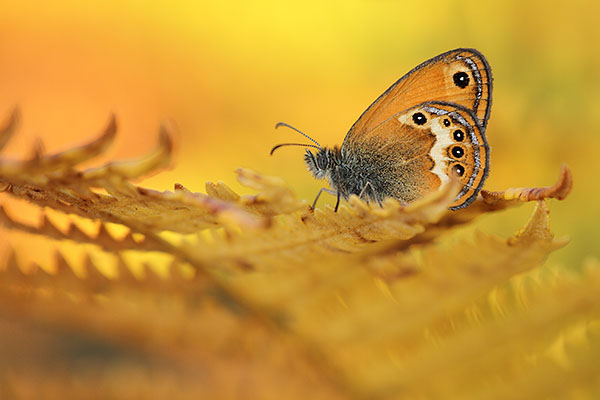
After this I do my best to take some better pictures of the various heath butterflies when I suddenly see a somewhat moth-eaten little butterfly flying past. I run after it for a while until the animal sits down for a while. And then this turns out to be the Plebejus villai - Elban Blue. Unfortunately it is already very worn, also because this is already the end of the flying time of this species, but I am still very happy that I found it. The butterfly is very nervous and keeps flying. Eventually I manage to take a sharp photo before the butterfly flies into an abyss and I can no longer follow it. Not perfect, but I am very satisfied.
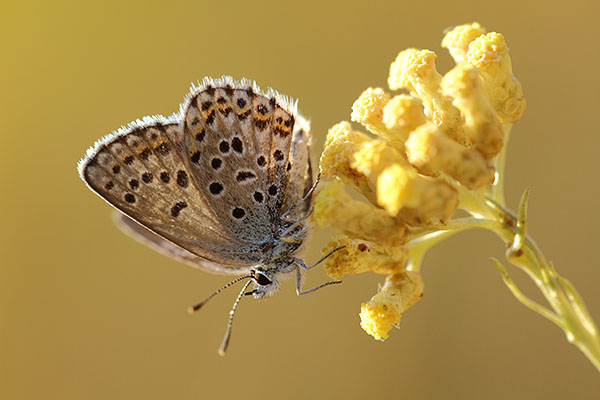
After this small success, I'm done with getting up early again. I have found my four new species and decide to lie back for the rest of the holiday and not worry about butterflies.
Tour of Germany, Austria and Switzerland 24-06/28-06-15
After working all day, I get in the car around 05:00 PM to pick up my father-in-law and Jordi Strijdhorst for a trip to the Alps. After a successful journey we arrive at our destination in southern Germany around 2:00 am. The weather is beautifully clear and the grass is already covered in dew, which gives us good hope for the next morning. We celebrate our successful trip with a beer, and then try to sleep in the car for a few hours. After lying down for about 2 hours the alarm goes off, it is still dark but we certainly don't want to be late. We gather our things and walk through the forest at dusk towards a beautiful raised bog area where we hope to find the Nehalennia speciosa - Pygmy Damselfly. The Pygmy Damselfly is a very rare damselfly that I once found with great difficulty in Poland. This time it is very different and we quite easily find different specimens neatly along the path. We start taking photos as quickly as possible, but the sun rises faster than we would like and soon the damselflies start turning and taking photos is almost impossible again. Ultimately it is disappointing to create exactly the picture you have in your head. In retrospect, I think the close-up below is the most beautiful. partly because you can clearly see through the drops in this photo how small this animal is. The other photos can be found here: Pygmy Damselfly – Nehalennia speciosa. All in all, it is definitely a place to go back to.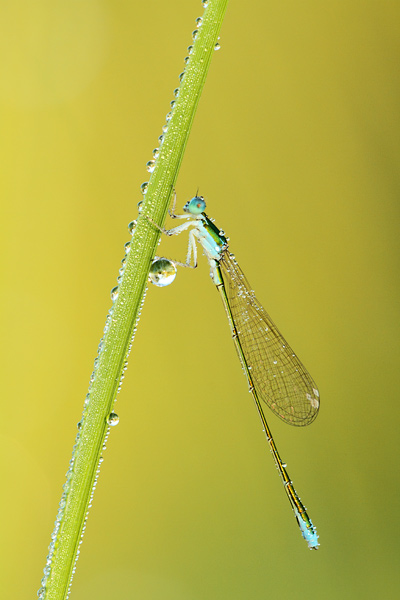
After this good start we get back in the car and arrive in Austria after a few hours where we hope to photograph the Coenagrion hylas - Siberian Bluet. Fortunately the weather is good and the first damselflies show up around noon. Unfortunately, as in previous years, taking a decent photo is not possible and we get back in the car a few hours later without having taken the desired photo.
After a long drive we arrive at our hotel in Switzerland around 7:00 PM. We sleep in a 12-person room in the basement, but fortunately we are the only ones who use this room. We have a beer and look at the photos of the day, then quickly head to bed.
The next morning the alarm goes off again around 5:00 am. Soon we are in the car and we start looking for the Small Apollo – Parnassius phoebus in the area. Here and there the grass is white from the frost, so it is quite chilly. Except for a few Small Apollo butterflies, we don't find anything at all. Of course, those few Small Apollos are also difficult to photograph. I tinker around a bit, but I can't take good pictures.
After having something to eat we go to a nearby lake in search of the Somatochlora alpestris - Alpine Emerald. After a long walk and about 2 hours of searching, we saw a hand full of emerald dragonflies, most of which were probably common emerald dragonflies. Not a great success and we decide to drive back to the hotel and look at some fields along the way. In all the places we stop it seems that it is still too early in the year and we cannot actually find any butterflies. It has probably been cold (too) long and the butterflies need some more time to emerge. When we stop at a field where we hope to find the Euphydryas intermedia - Asian Fritillary, it seems to be too late in the year again. Almost all the butterflies we find are already quite worn out. I try to make the best of it, but in the end it's not much good. However, there are still two Oeneis glacialis - Alpine Grayling flying around that are willing to cooperate reasonably well. In the end I take the only photo of this that I am somewhat satisfied with this day.
In the evening we have something to eat, and then quickly go to our room (basement).
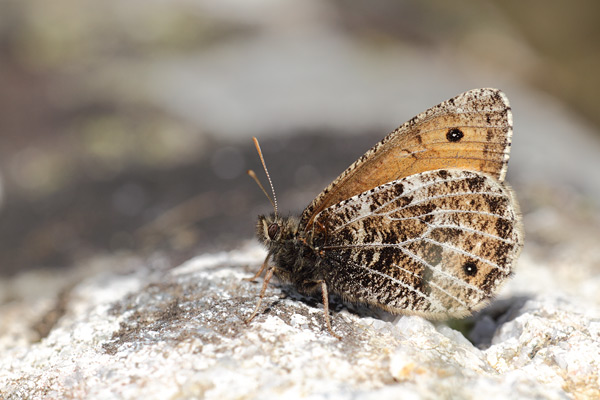
When the alarm goes off again the next morning around 05:00 am, we first drive to a slightly lower spot with the hope that there are already more butterflies there. Once we arrived, there are a few more butterflies here, but the numbers are still not what I expected. Again I take few photos and around 06:00 o'clock we move up a bit. Because the sun first has to pass over another mountain, we are still early enough. Again we go to the Little Apollo spot, this time I have more luck and I find a sleeping Small Apollo hanging among the flowers. Finally I take a photo that I am satisfied with.
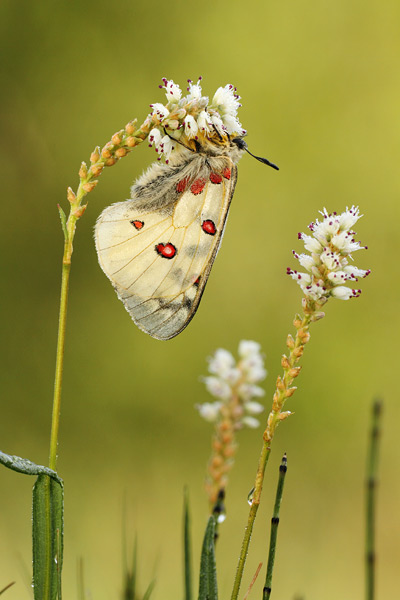
Soon it gets warmer and the butterflies start to fly. We drive to another pass and see if more butterflies fly here. Unfortunately, everything seems to be later than normal here too, but in this case it works out well because there are still fresh Pyrgus andromedae - Alpine Grizzled Skipper flying. This is exactly the kind that I always miss other years. If I can also take a photo on a beautiful mossy stone, I think it's great for a long time.
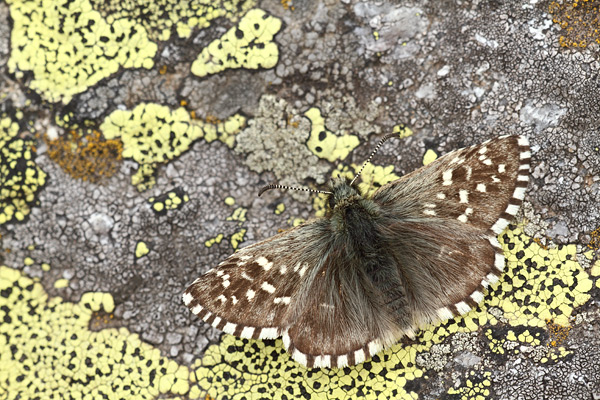
At the beginning of the afternoon I receive a phone call from Peter Groenedijk who has just arrived in Switzerland, and the four of us agree to go out together. We are looking for the Boloria thore - Thor's Fritillary. Probably due to the cold spring, this butterfly barely flies and we can only find one. He also does not allow himself to be photographed, and we walk further to find Shepherd fritillaries - Boloria pales. After a lot of effort we finally manage to find 2 butterflies, but soon it starts to rain heavily and we decide to go back to our hotel. We decide to relax for the rest of the day, have a beer and have pizza at my favorite pizza place in the evening.
The next morning we get up again around 5:00 am and make another quick walk. We start at the bottom of the mountain, where we already find a few more butterflies than at the start of our journey, but we don't want to take nice pictures. When we go back later to find the Shepherd's fritillary butterflies from yesterday, they also turn out to be untraceable, and we give up. We have breakfast in our hotel and then drive back to the Netherlands.
Romania (27-05/02-06)
At the end of May I went to Romania with Peter Groenendijk. Our trip initially went to Hungary where we wanted to make a stopover to find the Colias chrysotheme - Lesser Clouded Yelllow and to spend the night. Upon arrival the weather was not very good, and the number of butterflies was also very disappointing. With a lot of effort we were able to photograph an old and fledged female of the Colias chrysotheme butterfly. When we walked back to the car we were a bit lucky and found a fresh Issoria lathonia - Queen of Spain Fritillary that had already found a place to sleep. After taking pictures of this, the sun was almost setting and we started looking for a place to sleep.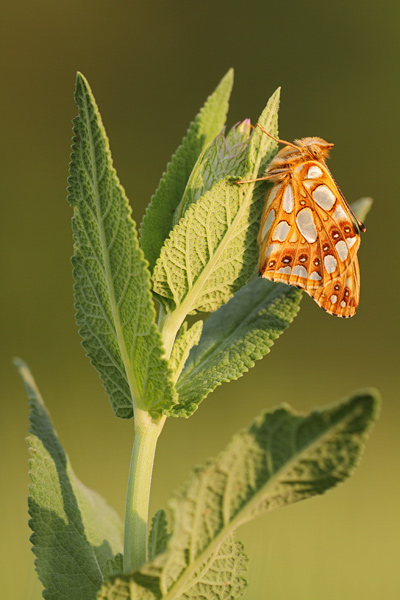
The next day we quickly drive further towards Romania. Once we arrive, we search several beautiful fields, but it seems that we are a bit early for most butterflies. We take some photos here and there, but unfortunately there is nothing special.
The next day we look for the Muschampia cribrellum - Spinose Skipper. For me, this butterfly is at the top of the list of butterflies I hope to find on this trip. In the morning we mainly find some blues, greens and the first Brenthis hecate - Twin Spot Fritillary, but the numbers are still very disappointing. After more than half a day of searching without success for the Muschampia cribrellum - Spinose Skipper, at the end of the afternoon we finally made a success and Peter found a couple that was mating on a Margriet. This gives us plenty of time to take a nice photo of these very rare butterflies. Not much happens after this, but the day is completely good.
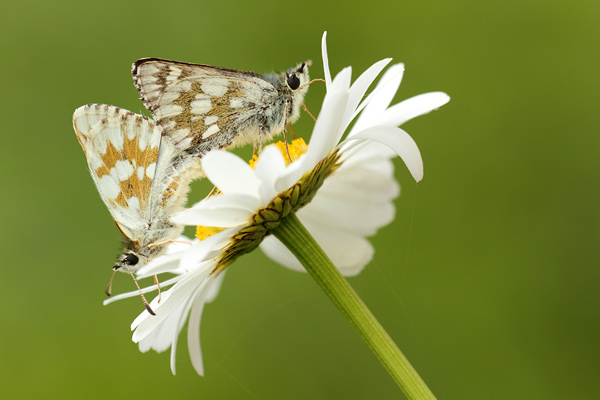
Because we found the Muschampia cribrellum - Spinose Skipper the previous day, today we will look for the Limenitis populi - Poplar Admiral and the Euphydryas maturna - Scarce Fritillary. Once we arrive, it is noticeable that some butterflies have already flown away while others have not even flown yet. We only find one Large Kingfisher that does not want to cooperate at all and therefore does not appear in the photo, the Neptis rivularis - Hungarian Glider seem shyer than usual and are impossible to photograph. Eventually I find a Euphydryas maturna - Scarce Fritillary that is willing to cooperate, and I take the only photo of the day.
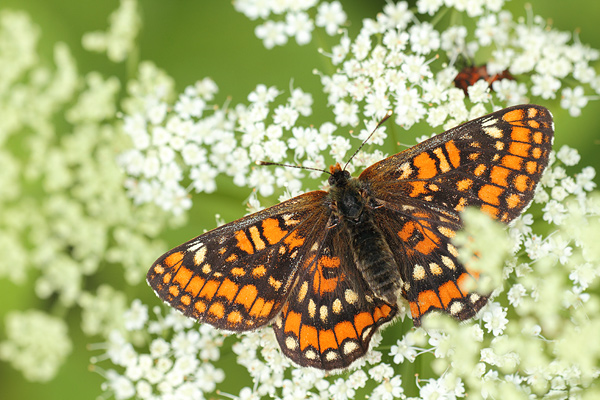
After a bad butterfly day, we head early today to the location of the Muschampia cribrellum - Spinose Skipper. Even before the sun rises above the hills we have found the first sleeping Muschampia cribrellum - Spinose Skipper and Pyrgus sidae - Yellow Banded Skipper. After more than an hour of fiddling around to take good pictures of these butterflies, we stay in the area where more butterflies are already flying, but it remains difficult. We especially hope to be able to take a nice photo of the Pyrgus sidae - Yellow Banded Skipper, but not many of these butterflies fly and they are very fast. By the end of the day, unfortunately, I still haven't been able to take many more special photos, and we decide to make one last attempt the next morning.
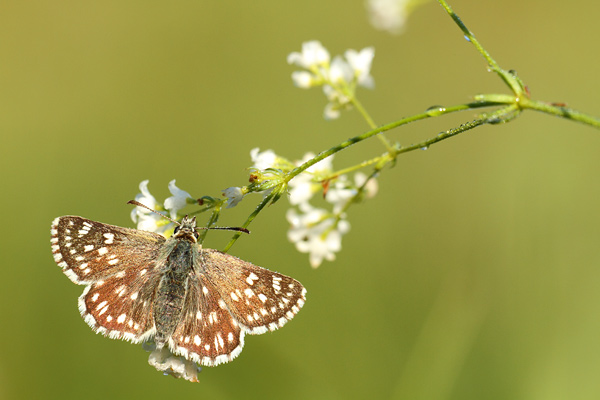
This morning the weather is nice again and we find two sleeping Yellow-banded Spotted Dirks, one of the two is the largest and most beautifully colored Yellow-banded Spotted Dirks I have ever seen. Fortunately, we have plenty of time and I take the most beautiful photo of this trip. I also take some pictures of bluebirds, but soon the weather is very warm and photography is impossible. We decide to pack our things and drive to northern Hungary to photograph Double-spotted Fritillary Butterflies - Brenthis hecate - the next day.
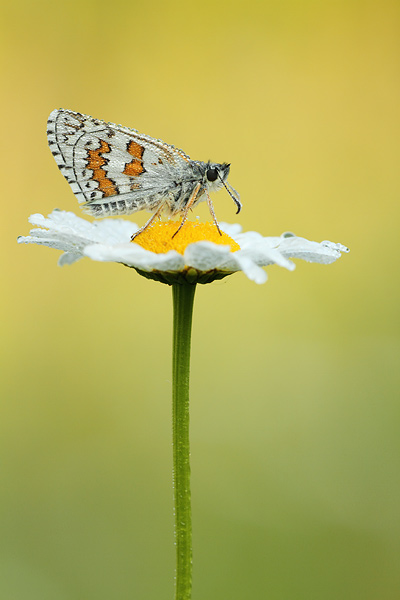
Before the sun has risen we walk again into a beautiful valley where it is normally swarming with butterflies, but here too everything is much later than we thought and there is little to be found. Ultimately we find two sleeping Double Spotted Fritillary Butterflies, which makes the day a little bit better, but we look no further and go home again.
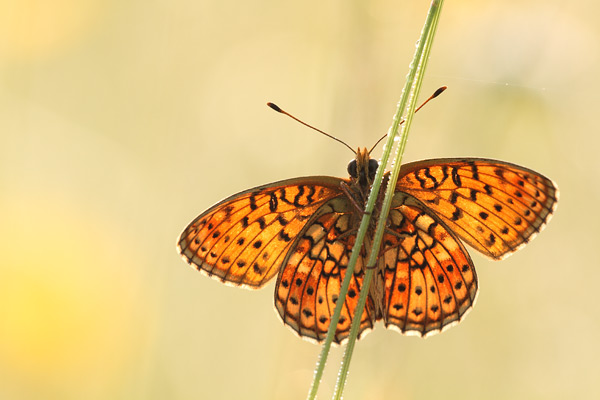
All in all, a fairly long journey with far fewer butterflies than we expected, but I'm glad I finally found the Muschampia cribrellum - Spinose Skipper.
National Geographic – tear-off calendar 2016
Yesterday a copy of the National Geagraphic tear-off calendar 2016 arrived on the mat with two of my favorite photos printed on it. Of course it's always nice if someone wants to use your photos, but if it's National Geographic, that's extra fun.Still waiting for the weather to improve, if it continues to rain like it is now, the butterfly season will soon be over.
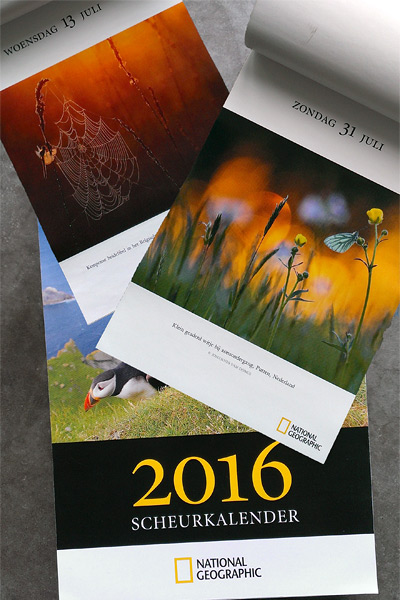
A lot happened
A lot has happened lately. As far as photos are concerned, I have been out and about quite a bit and have been able to make the necessary trips abroad. Generally not with very many new photos, but I still managed to capture some nice new species. Things are going a bit less well in my private/business life because I lost my job last month. So now I'm looking for another fun challenge after working more or less for the same company for 15 years. Despite this bad news, I still went on holiday with the family to Italy, from which I have just returned for a week. Now this afternoon we quickly take the car to Switzerland for a few days (despite the bad weather)Due to the large backlog of photos that I still have to put online, I will just continue where I left off and that is spring. In addition to the orange tips, I always try to look for the blue Heikker, which was not without success this year.
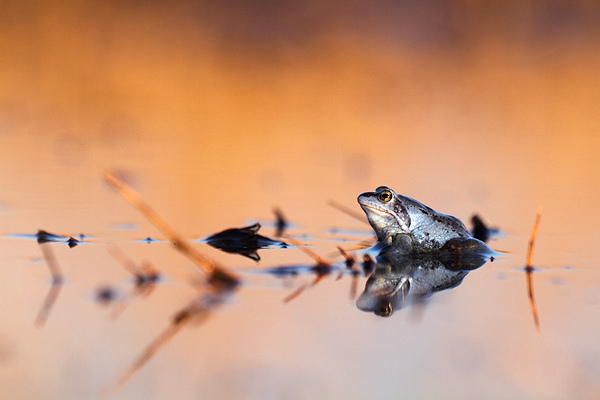
Then we went to the Weerribben twice in search of dragonflies and damselflies. The first time there was not much to be found as far as dragonflies were concerned, so I started working on damselflies again. The result is a small Fire Damselfly hanging between the wet grass in beautiful backlight.
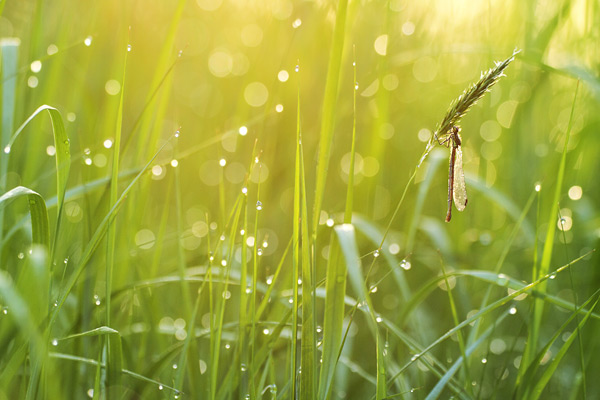
On the second visit to the Weerribben I hoped to find more dragonflies. This was a bit disappointing at first, but eventually I found a dewy Glass Cutter beautifully hanging free along a path. (sometimes it's that easy) If the sun also shines beautifully in the background, the picture is complete.
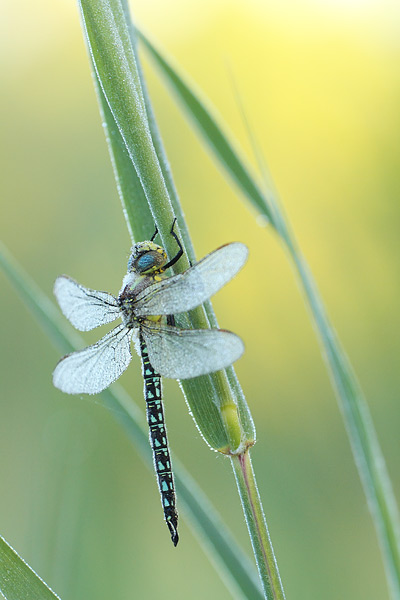
A sign of life
July 6, 2015 Finally a new message on my website. Over the past year I have been very busy with work, doing work on my house and updating my website. In any case, my website is now as good as ready, I hope everything has become clearer and more organized.Because of all the hustle and bustle, I didn't take a lot of photos, but I certainly didn't sit still either. At the end of May I went to Romania for a few days and at the end of June I made a short tour through Germany, Austria and Switzerland. The numbers of butterflies were a bit disappointing everywhere due to the cold spring, but I was still able to take some nice pictures here and there. These photos will follow later, I will first start at the beginning of 2015 with the Anthocharis cardamines - Orange Tip.
Like every year, the butterfly year starts with these butterflies and this year was no different, I think I managed to take a better photo again, but I certainly hope to be able to take a better photo again next year.
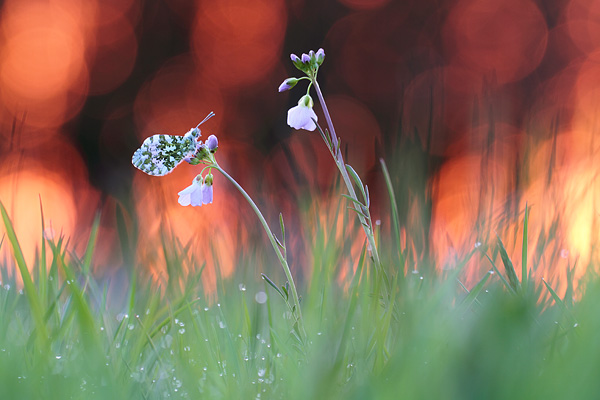
Unfortunately my next blog update will have to wait a while. First I will leave for Italy with my family on Thursday to enjoy our summer holiday there for 3 weeks. And hopefully take a few pictures too.
Archive:
Blog 2023
Blog 2022
Blog 2021
Blog 2020
Blog 2019
Blog 2018
Blog 2017
Blog 2016
Blog 2015
Blog 2014
Blog 2013
Blog 2012
Blog 2011
Blog 2010
Blog 2002 - 2009
Links: Peter Groenendijk Bernard Fransen Jordi Strijdhorst Johannes Klapwijk Matt Rowlings Guy Padfield Roger Gibbons Morten S. Molgaard
Links: Peter Groenendijk Bernard Fransen Jordi Strijdhorst Johannes Klapwijk Matt Rowlings Guy Padfield Roger Gibbons Morten S. Molgaard